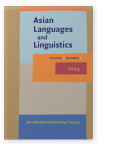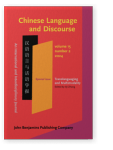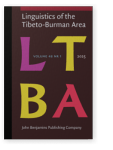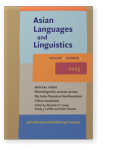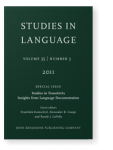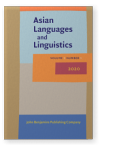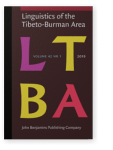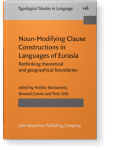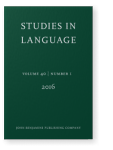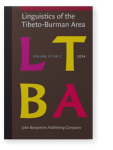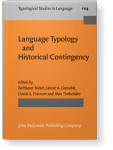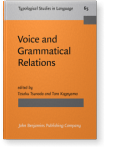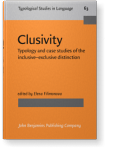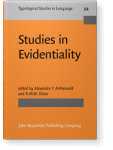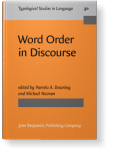Randy J. LaPolla
List of John Benjamins publications for which Randy J. LaPolla plays a role.
Journals
ISSN 1877-7031 | E-ISSN 1877-8798
ISSN 0731-3500 | E-ISSN 2214-5907
Titles
Ethnolinguistic contact across the Indo-Myanmar-Southwestern China mountains
Edited by Alexander R. Coupe, Randy J. LaPolla and Hideo Sawada
Special issue of Asian Languages and Linguistics 4:2 (2023) v, 218 pp.
Subjects Afro-Asiatic languages | Altaic languages | Dravidian languages | Historical linguistics | Japanese linguistics | Sino-Tibetan languages | Theoretical linguistics | Turkic languages | Typology | Uralic languages
Language Structure and Environment: Social, cultural, and natural factors
Edited by Rik De Busser and Randy J. LaPolla
[Cognitive Linguistic Studies in Cultural Contexts, 6] 2015. vi, 370 pp.
Subjects Anthropological Linguistics | Cognition and language | Sociolinguistics and Dialectology | Theoretical linguistics
Studies in Transitivity: Insights from Language Documentation
Edited by František Kratochvíl, Alexander R. Coupe and Randy J. LaPolla
Special issue of Studies in Language 35:3 (2011) v, 266 pp.
Subjects Functional linguistics | Theoretical linguistics | Typology
2023 Ethnolinguistic contact across the Indo-Myanmar-Southwestern China mountains Ethnolinguistic contact across the Indo-Myanmar-Southwestern China mountains, Coupe, Alexander R., Randy J. LaPolla and Hideo Sawada (eds.), pp. 113–118 | Introduction
2023 Manifestations of Jinghpaw influence among Rawang speakers Ethnolinguistic contact across the Indo-Myanmar-Southwestern China mountains, Coupe, Alexander R., Randy J. LaPolla and Hideo Sawada (eds.), pp. 273–290 | Article
Rawang and Jinghpaw, while both considered part of the larger Kachin ethnic group, are not seen to be closely related, though both retain proto-Tibeto-Burman forms relatively well. But as essentially all Rawang speakers speak Jinghpaw, there are a lot of loan words from Jinghpaw in Rawang, and… read more
2020 Forward to the past: Modernizing linguistic typology by returning to its roots Asian Languages and Linguistics 1:1, pp. 147–167 | Article
This paper argues that linguistic typology, and linguistics more generally, got off to a good start in the 19th century with scholars like Wilhelm von Humboldt and Georg von der Gabelentz, where the understanding was that each language manifests a unique world view, and it is important to study… read more
2019 A note on the history of the term “pronomenalisation” Linguistics of the Tibeto-Burman Area 42:1, pp. 143–147 | Article
This short note discusses the origin and development of the use of the term “pronomenalisation” (pronominalization) in Sino-Tibetan linguistics, pointing out that the concept was originally a typological one, and that the phenomenon was seen as the result of grammaticalization, i.e. the free… read more
2017 Noun-modifying clause constructions in Sino-Tibetan languages Noun-Modifying Clause Constructions in Languages of Eurasia: Rethinking theoretical and geographical boundaries, Matsumoto, Yoshiko, Bernard Comrie and Peter Sells (eds.), pp. 91–103 | Article
After a short background introduction on Sino-Tibetan noun modifying clause constructions generally, this paper demonstrates, using naturally occurring data, that the Mandarin pre-head noun-modifying clausal construction is grammatically unlike a relative clause construction, as normally conceived,… read more
2016 Review of Evans (2014): The language myth: Why language is not an instinct Studies in Language 40:1, pp. 235–252 | Review
2016 Once again on methodology and argumentation in linguistics: Problems with the arguments for recasting Sino-Tibetan as “Trans-Himalayan” Linguistics of the Tibeto-Burman Area 39:2, pp. 282–297 | Article
There have been challenges to the received view of the structure of the Sino-Tibetan language family. This is all well and good, as we should constantly challenge our most basic assumptions. In this paper I look at the arguments presented with a view to convincing us to change our conception of… read more
2015 Chapter 2. On the logical necessity of a cultural and cognitive connection for the origin of all aspects of linguistic structure Language Structure and Environment: Social, cultural, and natural factors, De Busser, Rik and Randy J. LaPolla (eds.), pp. 31–44 | Article
This chapter presents a view of communication not as coding and decoding, but as ostension and inference, that is, one person doing something to show the intention to communicate, and then another person using abductive inference to infer the reason for the person’s ostensive act, creating a… read more
2014 Towards a new approach to evidentiality: Issues and directions for research Linguistics of the Tibeto-Burman Area 37:2, pp. 240–263 | Article
Evidentiality is often defined as the grammatical means of expressing information source. This paper argues for a broader definition of evidentials, as close work documenting languages has shown that simply saying evidentials mark source of information does not capture all of the actual uses of… read more
2013 Subgrouping in Tibeto-Burman: Can an individual-identifying standard be developed? How do we factor in the history of migrations and language contact? Language Typology and Historical Contingency: In honor of Johanna Nichols, Bickel, Balthasar, Lenore A. Grenoble, David A. Peterson and Alan Timberlake (eds.), pp. 463–474 | Article
This paper is an attempt to apply insights and methodologies from Nichols (1996) to help us resolve problems in determining genetic relatedness among Sino-Tibetan languages and in our efforts at reconstructing protolanguages of different time depths. The results from the application of Nichols’s… read more
2011 On transitivity in two Tibeto-Burman languages Studies in Transitivity: Insights from Language Documentation, Kratochvíl, František, Alexander R. Coupe and Randy J. LaPolla (eds.), pp. 636–649 | Article
This paper presents the analyses of transitivity and questions about transitivity in two languages (Rawang and Qiang) that have been described using very different definitions of transitivity, with a view to showing that each language must be analysed on its own terms, and so the criteria used for… read more
2011 On Transitivity Studies in Transitivity: Insights from Language Documentation, Kratochvíl, František, Alexander R. Coupe and Randy J. LaPolla (eds.), pp. 469–492 | Article
This paper critically discusses and contrasts some of the different conceptualisations of transitivity that have been presented in the literature, and argues that transitivity as a morphosyntactic phenomenon and effectiveness of an event as a semantic concept should be separated in discussions of… read more
2006 On grammatical relations as constraints on referent identification Voice and Grammatical Relations: In Honor of Masayoshi Shibatani, Tsunoda, Tasaku and Taro Kageyama (eds.), pp. 139–151 | Article
2005 The inclusive-exclusive distinction in Tibeto-Burman languages Clusivity: Typology and case studies of the inclusive–exclusive distinction, Filimonova, Elena (ed.), pp. 291–311 | Chapter
2003 3. Evidentiality in Qiang Studies in Evidentiality, Aikhenvald, Alexandra Y. and R.M.W. Dixon (eds.), pp. 63–78 | Chapter
1996 Book Review (2) International Review of Chinese Linguistics 1:1, pp. 92–100 | Review
1995 Pragmatic relations and word order in Chinese Word Order in Discourse, Downing, Pamela A. and Michael Noonan (eds.), pp. 297–329 | Article
